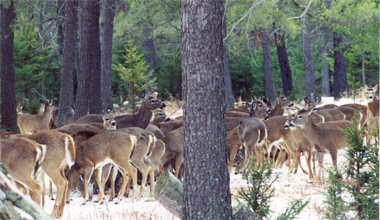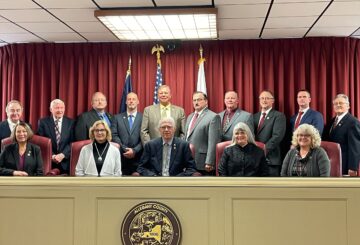State wildlife agency reminds the public it is illegal to feed wild deer
Feeding of white-tailed deer causes unnatural concentrations near the food source, which can lead to ecological damage, damage to property, and an increased risk of transmission of disease between deer.
NYS Environmental Conservation Law 11-0505 prohibits:
- feeding or enticing deer to be fed within 300 feet of public road; and
- establishing a salt lick on land inhabited by deer.
NYS Codes, Rules and Regulations Part 186 further prohibits all intentional feeding of wild deer or moose except for several specific circumstances. Incidental feeding such as attraction of deer or moose to a birdfeeder will only be considered a violation if DEC has previously issued a written warning to the person responsible.
Exceptions to the feeding prohibition include:
- DEC issued research license, management permit, or 4-Poster TickicideTM license;
- planting, cultivating, or harvesting of vegetation associated with normal agricultural or horticultural practices;
- planting, cultivating, or harvesting plants to enhance wildlife habitat conditions;
- distribution of food material for livestock directly associated with livestock husbandry;
- distribution of food material for legally possessed captive animals of the family Cervidae where measures are in place to eliminate the availability of food material to deer or moose; and
- cutting of trees or brush.
Deer Survival Without Supplemental Feed
If feeding is curtailed, some deer may starve at traditional feeding sites because their population is artificially above the carrying capacity of the winter habitat. Moreover, the winter habitat surrounding the feeding site may be damaged from overbrowsing. Some deer will shift activity patterns to take advantage of better winter cover than that which existed at the feeding site. After several years with no deer feeding, the deer population will again be in balance with the natural habitat.
It is normal for some deer to starve during severe winters in northern forests, leaving the stronger deer to reproduce. Some young deer simply do not reach adequate body size and physical condition to survive even average winter conditions. On the other hand, deer populations tend to increase following milder winters. When summer and fall habitats are maintained in good quality, deer are better prepared to survive harsh winter conditions.

In northern latitudes when snow depths increase, deer often congregate in winter yards, which are typically areas of conifer cover that provide greater shelter from deep snows and slightly more moderate temperatures. This is a natural behavior, with the deer prioritizing shelter over food resources. Although the deer are more concentrated than during other times of year, the risk of disease transmission is lower in winter yards than at artificial feeding sites because feeding activity is dispersed. Natural browse is consumed and not immediately replaced. At artificial feeding sites, deer are in closer contact. The food is replaced at the same location repeatedly, increasing the likelihood of direct contact between animals.
The best way to improve deer survival through winter is to improve the quality of their summer and fall habitat and natural food sources. Additionally, cutting trees and brush in deer winter yards makes the browse in the tops of the trees or brush accessible to deer. This browse is the food deer are adapted to eat in the winter. This cutting can only be done on private land with the permission of the landowner. It cannot be done on state forest preserve land and requires permits on other state lands. The landowner can use the trunks of the trees for firewood or timber, leaving the tops for deer to eat. Anyone interested in providing browse to deer by cutting trees or brush can contact their regional DEC deer biologist for suggestions on tree species and quantities or visit the winter deer foods page.






